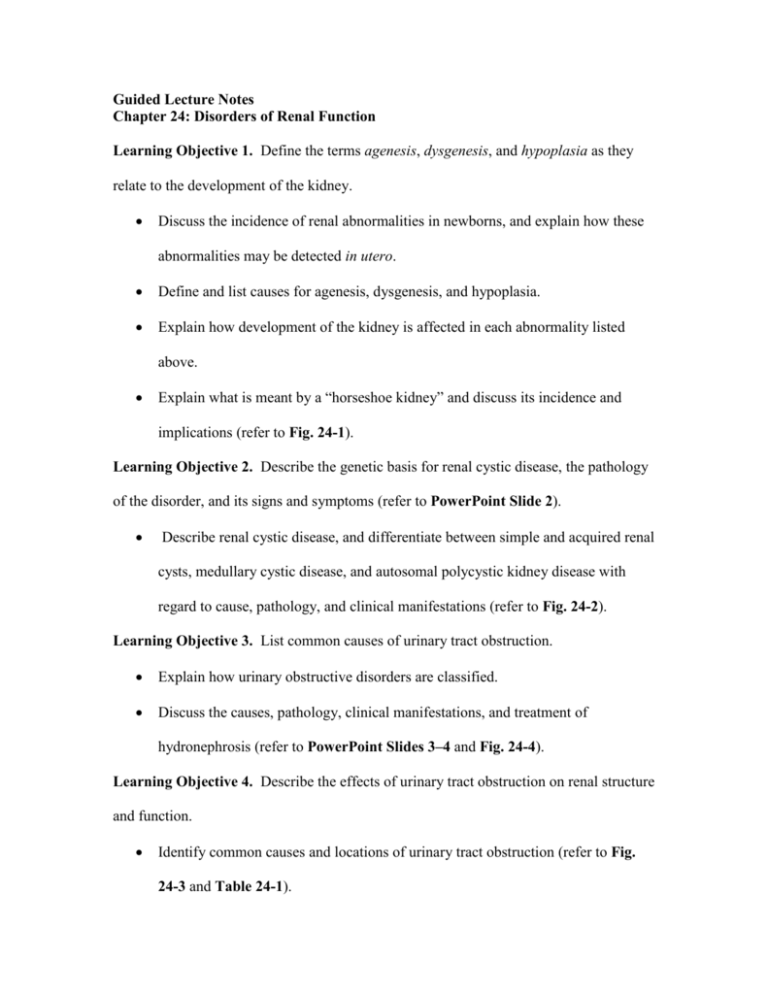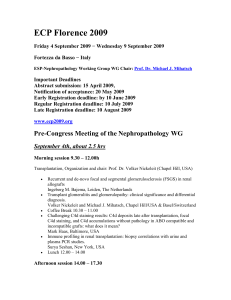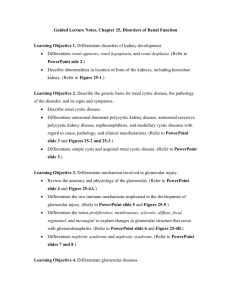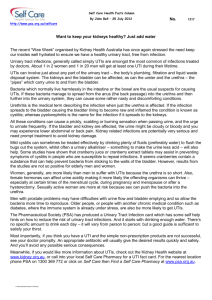Ch24
advertisement

Guided Lecture Notes Chapter 24: Disorders of Renal Function Learning Objective 1. Define the terms agenesis, dysgenesis, and hypoplasia as they relate to the development of the kidney. Discuss the incidence of renal abnormalities in newborns, and explain how these abnormalities may be detected in utero. Define and list causes for agenesis, dysgenesis, and hypoplasia. Explain how development of the kidney is affected in each abnormality listed above. Explain what is meant by a “horseshoe kidney” and discuss its incidence and implications (refer to Fig. 24-1). Learning Objective 2. Describe the genetic basis for renal cystic disease, the pathology of the disorder, and its signs and symptoms (refer to PowerPoint Slide 2). Describe renal cystic disease, and differentiate between simple and acquired renal cysts, medullary cystic disease, and autosomal polycystic kidney disease with regard to cause, pathology, and clinical manifestations (refer to Fig. 24-2). Learning Objective 3. List common causes of urinary tract obstruction. Explain how urinary obstructive disorders are classified. Discuss the causes, pathology, clinical manifestations, and treatment of hydronephrosis (refer to PowerPoint Slides 3–4 and Fig. 24-4). Learning Objective 4. Describe the effects of urinary tract obstruction on renal structure and function. Identify common causes and locations of urinary tract obstruction (refer to Fig. 24-3 and Table 24-1). Learning Objective 5. Cite three theories that are used to explain the formation of kidney stones. Describe the anatomy and pathology of a kidney stone/calculus. Discuss the merits of the saturation, matrix, and inhibitor theories as they relate to the formation of calculi (refer to PowerPoint Slide 7). Compare the various types of kidney stones (refer to Table 24-2). Learning Objective 6. Explain the mechanisms of pain and infection that occur with kidney stones. Describe the common clinical manifestations of kidney stones. Learning Objective 7. Describe methods used in the diagnosis and treatment of kidney stones. Describe the methods used to diagnose kidney stones, and discuss treatment options. Learning Objective 8. Cite organisms most responsible for UTIs and state why urinary catheters, obstruction, and reflux predispose to infections. List the most common causative organisms for UTIs, and discuss their incidence (refer to PowerPoint Slide 8). List factors that predispose individuals to UTIs. Explain how urinary obstruction, reflux, and the presence of catheters increase the likelihood of UTIs. Learning Objective 9. List three physiologic mechanisms that protect against UTIs. Describe host defense mechanisms against UTIs (refer to PowerPoint Slide 8). Learning Objective 10. Compare the signs and symptoms of upper and lower UTIs. Differentiate between upper and lower UTIs with regard to clinical manifestations, diagnosis, and treatment. Learning Objective 11. Describe factors that predispose to UTIs in children, sexually active women, pregnant women, and older adults. Discuss why UTIs are more common in women, and identify risk factors in children, women, and the elderly that predispose them to UTIs. Learning Objective 12. Compare the manifestations of UTIs in different age groups, including infants, toddlers, adults, and older adults. Describe the signs and symptoms of UTIs, and explain how they differ in infants and children, women, and the elderly. Learning Objective 13. Cite measures used in the diagnosis and treatment of UTIs. Discuss diagnostic methods and treatment options associated with UTIs. Learning Objective 14. Describe two types of immune mechanism involved in glomerular disorders. Review the anatomy and physiology of the glomerulus (refer to PowerPoint Slide 12). Describe the immune mechanisms implicated in the development of glomerular disease (refer to PowerPoint Slide 13 and Fig. 24-8). Learning Objective 15. Use the terms proliferation, sclerosis, membranous, diffuse, focal, segmental and mesangial to explain changes in glomerular structure that occur with glomerulonephritis. Identify the main categories of glomerular disease. Explain how the structure and function of the glomerulus is altered in glomerulonephritis (refer to PowerPoint Slide 14 and Fig. 24-7). Learning Objective 16. Relate the proteinuria, hematuria, pyuria, oliguria, edema, hypertension, and azotemia that occur with glomerulonephritis to changes in glomerular structure. Explain how the changes that occur in glomerular structure result in the clinical manifestations seen in glomerulonephritis. Learning Objective 17. Differentiate the pathology and manifestations of nephrotic syndrome from those of the nephritic syndromes (refer to PowerPoint Slides 15–17). Compare the causes, pathology, clinical manifestations, diagnosis, and treatment of nephritic and nephrotic syndromes (refer to Fig. 24-9). Learning Objective 18. Cite a definition of tubulointerstitial kidney disease. Identify the tissue affected in tubulointerstitial disorders. Define pyelonephritis, and differentiate between its acute and chronic forms with regard to pathology, clinical manifestations, diagnosis, and treatment (refer to PowerPoint Slide 23 and Figs. 24-6 and 24-10). Learning Objective 19. Explain the vulnerability of the kidneys to injury caused by drugs and toxins. Explain why the kidneys’ high blood flow, filtration pressure, and metabolic function predispose them to injury due to drugs and toxins. Describe how drugs and toxins damage the kidneys (refer to PowerPoint Slide 23). Differentiate between acute drug-related hypersensitivity reactions and chronic analgesic nephritis with regard to causes, clinical manifestations, and treatment. Learning Objective 20. Characterize Wilms tumor in terms of age of onset, possible oncogenic origin, manifestations, and treatment. Describe the etiology, pathology, clinical manifestations, diagnosis, and treatment of the embryonic kidney cancer called Wilms tumor (nephroblastoma) (refer to Fig. 24-11). Learning Objective 21. Cite the risk factors for renal cell carcinoma, describe the manifestations, and explain why the 5-year survival rate has been so low. Identify risk factors for adult kidney cancer and discuss its incidence, pathology, clinical manifestations, diagnosis, and treatment.









